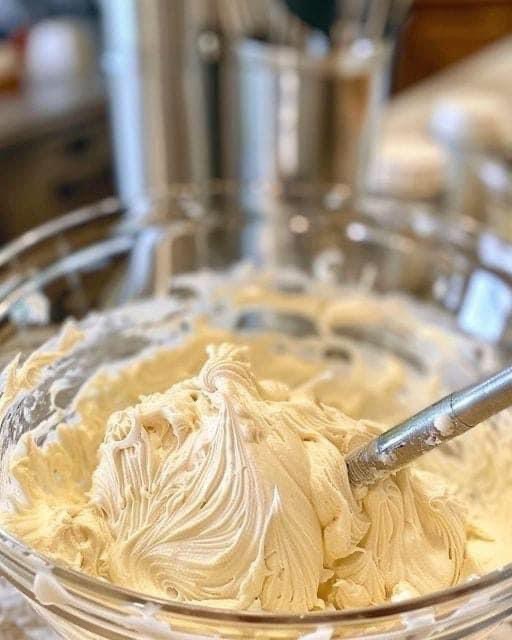Buttercream

Introduction
Crème au beurre, or buttercream, is a classic French frosting that epitomizes the essence of indulgence. Rich, smooth, and versatile, this delectable cream is often used to frost cakes, fill pastries, and add elegance to a wide range of desserts. With origins deeply rooted in French patisserie, crème au beurre is beloved for its delicate balance of sweetness and creaminess, achieved through a harmonious blend of butter, sugar, and sometimes egg yolks or whites. Let’s delve into the history, ingredients, benefits, and the art of making this luxurious frosting.
History of Crème au Beurre
Buttercream, or “crème au beurre,” first appeared in French culinary records in the 19th century. This frosting was quickly adopted by French pâtissiers for its exceptional versatility and ability to hold its shape, making it ideal for decorating cakes and other desserts. Traditionally, French buttercream is made by beating butter into a meringue or a yolk-based custard, resulting in a rich and silky texture. Today, there are several variations of buttercream around the world, but the French version remains a beloved classic, admired for its luxurious taste and texture.
Ingredients
- Egg yolks or whites: 4 large (depending on the type of buttercream; whites for meringue-based, yolks for custard-based)
- Granulated sugar: 1 cup (200g)
- Water: 1/4 cup (60ml)
- Unsalted butter: 1 1/2 cups (340g), softened to room temperature
- Vanilla extract: 2 teaspoons (optional)
- Pinch of salt
Preparation and Method
- Prepare the sugar syrup: In a small saucepan, combine the granulated sugar and water. Heat over medium heat, stirring occasionally, until the sugar is fully dissolved. Once the sugar is dissolved, increase the heat to medium-high and bring the syrup to a boil. Continue to cook until it reaches 240°F (115°C) on a candy thermometer (soft-ball stage).
- Whip the eggs: While the sugar syrup is boiling, begin whipping the egg yolks or whites in a stand mixer with a whisk attachment at medium speed until they become pale and fluffy. If using egg whites, ensure they form soft peaks.
- Combine syrup and eggs: Once the sugar syrup reaches the desired temperature, slowly and carefully pour it in a thin stream into the whipped eggs while continuing to whisk at medium speed. Be cautious to avoid splashing the hot syrup.
- Whip until cooled: Increase the mixer speed to high and continue whisking the mixture until it has cooled to room temperature. This process should take about 5–10 minutes. The mixture should be thick, glossy, and at room temperature before adding the butter.
- Incorporate the butter: Reduce the mixer speed to medium-low and begin adding the softened butter one tablespoon at a time. Ensure each addition is fully incorporated before adding the next. Continue until all the butter is mixed in, and the buttercream is smooth, fluffy, and creamy. Add vanilla extract and a pinch of salt, if desired.
- Final adjustments: Taste the buttercream and adjust the flavorings if necessary. If the mixture appears curdled, continue to beat on medium speed until it becomes smooth again.
Formation and Use
Crème au beurre can be used immediately or stored in an airtight container in the refrigerator for up to a week. When ready to use, bring it back to room temperature and re-whip to restore its creamy consistency. It can be piped onto cakes, cupcakes, or used as a filling for pastries like éclairs or macarons.
Nutritional Information (per serving, approximately 2 tablespoons)
- Calories: 180
- Fat: 18g
- Saturated Fat: 11g
- Cholesterol: 70mg
- Sodium: 10mg
- Carbohydrates: 5g
- Sugar: 5g
- Protein: 1g
Benefits of Crème au Beurre
- Versatility: Crème au beurre is incredibly versatile and can be flavored with a variety of ingredients, including vanilla, chocolate, coffee, fruit purees, or liquors, allowing for endless creative possibilities in baking.
- Texture and Stability: Unlike other frostings, buttercream holds its shape well, making it perfect for intricate cake decorations and piping designs.
- Richness: The high butter content gives it a rich and creamy texture that enhances the flavor of any dessert.
- Customizability: The basic recipe can be easily adapted to accommodate dietary preferences, such as making a dairy-free version using vegan butter.
Conclusion
Crème au beurre is not just a frosting; it is a celebration of classic French pastry artistry. With its silky smooth texture and rich, buttery flavor, it brings sophistication and elegance to any dessert. Whether you’re looking to elevate a simple cake or create an elaborate pastry masterpiece, this buttercream is sure to impress.
Tips for Crème au Beurre Lovers
- Temperature is Key: Ensure all ingredients, especially butter, are at room temperature to prevent curdling or splitting.
- Patience and Practice: Making crème au beurre can be a bit tricky, but with practice, you will master the technique. Don’t be discouraged if it doesn’t come out perfect the first time.
- Experiment with Flavors: Infuse your buttercream with different flavors to complement your dessert, from fruity flavors to nutty or even herbal infusions.
Final Thoughts
For those who love the rich, creamy, and luxurious taste of French desserts, crème au beurre is a must-try recipe. With a bit of practice and patience, you can bring a touch of French elegance to your kitchen. Enjoy the process, savor the taste, and let your creativity shine in every dessert you make with this exquisite buttercream! I